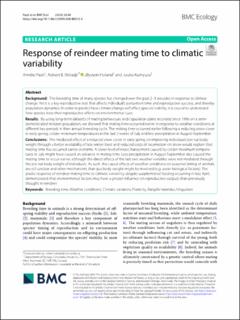| dc.contributor.author | Paoli, Amelie | |
| dc.contributor.author | Weladji, Robert B. | |
| dc.contributor.author | Holand, Øystein | |
| dc.contributor.author | Kumpula, Jouko | |
| dc.date.accessioned | 2021-06-21T10:26:49Z | |
| dc.date.available | 2021-06-21T10:26:49Z | |
| dc.date.created | 2021-01-26T18:26:22Z | |
| dc.date.issued | 2020 | |
| dc.identifier.citation | BMC Ecology. 2020, 20 . | en_US |
| dc.identifier.issn | 1472-6785 | |
| dc.identifier.uri | https://hdl.handle.net/11250/2760371 | |
| dc.description.abstract | Background: The breeding time of many species has changed over the past 2–3 decades in response to climate change. Yet it is a key reproductive trait that afects individual’s parturition time and reproductive success, and thereby population dynamics. In order to predict how climate change will afect species’ viability, it is crucial to understand how species base their reproductive eforts on environmental cues. Results: By using long-term datasets of mating behaviours and copulation dates recorded since 1996 on a semidomesticated reindeer population, we showed that mating time occurred earlier in response to weather conditions at diferent key periods in their annual breeding cycle. The mating time occurred earlier following a reducing snow cover in early spring, colder minimum temperatures in the last 2 weeks of July and less precipitation in August-September. Conclusions: The mediated efect of a reduced snow cover in early spring on improving individuals’ pre-rut body weight through a better availability of late winter food and reduced costs of locomotion on snow would explain that mating time has occurred earlier overtime. A lower level of insect harassment caused by colder maximum temperatures in July might have caused an advance in mating time. Less precipitation in August-September also caused the mating time to occur earlier, although the direct efects of the last two weather variables were not mediated through the pre-rut body weight of individuals. As such, the causal efects of weather conditions on seasonal timing of animals are still unclear and other mechanisms than just body weight might be involved (e.g. socio-biological factors). The plastic response of reindeer mating time to climatic variability, despite supplemental feeding occurring in late April, demonstrated that environmental factors may have a greater infuence on reproductive outputs than previously thought in reindeer. | en_US |
| dc.language.iso | eng | en_US |
| dc.rights | Navngivelse 4.0 Internasjonal | * |
| dc.rights.uri | http://creativecommons.org/licenses/by/4.0/deed.no | * |
| dc.title | Response of reindeer mating time to climatic variability | en_US |
| dc.type | Peer reviewed | en_US |
| dc.type | Journal article | en_US |
| dc.description.version | publishedVersion | en_US |
| dc.source.pagenumber | 13 | en_US |
| dc.source.volume | 20 | en_US |
| dc.source.journal | BMC Ecology | en_US |
| dc.identifier.doi | 10.1186/s12898-020-00312-8 | |
| dc.identifier.cristin | 1879883 | |
| dc.relation.project | NORAD, direktoratet for utviklingssamarbeid: 76915 ReiGN | en_US |
| cristin.ispublished | true | |
| cristin.fulltext | original | |
| cristin.qualitycode | 1 | |

